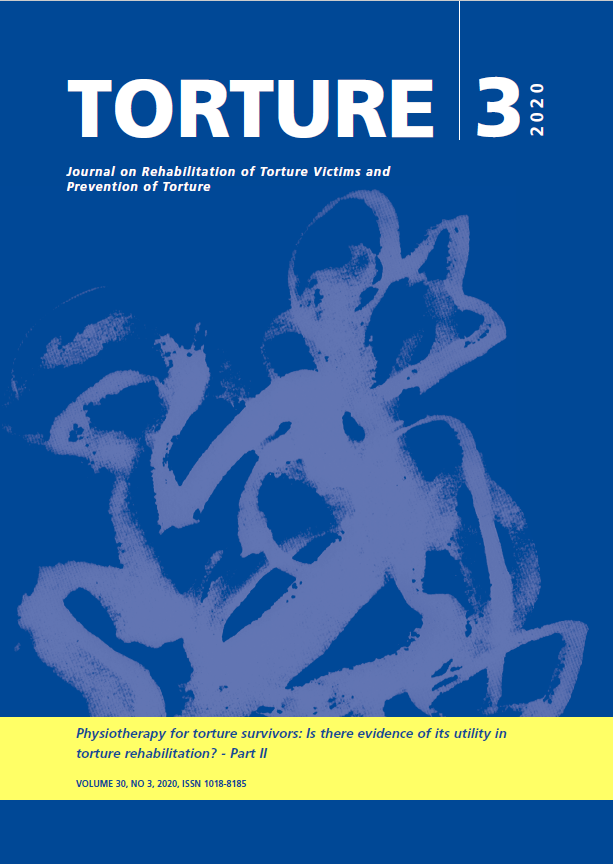Collaborative effort to increase the physiotherapist’s competency in rehabilitation of torture survivors
DOI:
https://doi.org/10.7146/torture.v30i3.121793Keywords:
Torture, refugees, physiotherapyAbstract
Thank you for this opportunity to share perspectives from our work within the Physiotherapy and Refugees Education Project, PREP, an Erasmus+ funded project within the KA2 strategic partnership program. Researchers, educators, students, and clinicians within institutions of higher education, health services and humanitarian organisations, have worked together in this project to define competencies that physiotherapists need in working with refugees. Based on this, we have made a course openly available for physiotherapists worldwide. A central aim of the work in PREP has been the creation of a network in which educators, students and clinicians can meet, discuss, and learn from each other. We welcome everyone who shares our interest to join us in this network. In this perspective paper, we want to share our thoughts and opinions on how such a collaboration can be used for building competence. We will discuss topics that are central for physiotherapists working with victims of torture, and finally, we will discuss what we believe are the important next steps within physiotherapy to be able to support this group.
References
Bath, H. (2008). The three pillars of trauma-informed care. Reclaiming children and youth, 17(3), 17.
Bessette, J., Généreux, M., Thomas, A., & Camden, C. (2020). Teaching and assessing advocacy in Canadian physiotherapy programmes. Physiotherapy Canada, 72(3), 305-312. https://doi.org/10.3138/ptc-2019-0013
Blessinger, P., Sengupta, E., Mahoney, C. (2019). Towards higher education for a better society. Patrickblessinger.com. https://www.patrickblessinger.com/towards-higher-education-for-a-better-civil-society/
Brzoska, P., & Razum, O. (2017). Challenges of Diversity-Sensitive Care in Medical Rehabilitation. Die Rehabilitation, 56(5), 299. https://doi.org/10.1055/s-0043-100014
Flynn, L., & Verma, S. (2008). Fundamental components of a curriculum for residents in health advocacy. Medical teacher, 30(7), e178-e183. https://doi.org/10.1080/01421590802139757
Gamble, A., Ahmed, A. M. A., Rahim, S. H., & Hartman, J. (2020). The effects of a combined psychotherapy and physiotherapy group treatment program for survivors of torture incarcerated in an adult prison in Kurdistan, Iraq: A pilot study. Torture Journal, 30(2), 58-76. https://doi.org/10.7146/torture.v30i2.119199
Kelland, K., Hoe, E., McGuire, M. J., Yu, J., Andreoli, A., & Nixon, S. A. (2014). Excelling in the role of advocate: a qualitative study exploring advocacy as an essential physiotherapy competency. Physiotherapy Canada, 66(1), 74-80. https://doi.org/ 10.3138/ptc.2013-05
Khan, F., & Amatya, B. (2017). Refugee health and rehabilitation: challenges and response. Journal of rehabilitation medicine, 49(5), 378-384. https://doi.org/10.2340/16501977-2223
Lindsay, S., King, G., Klassen, A. F., Esses, V., & Stachel, M. (2012). Working with immigrant families raising a child with a disability: challenges and recommendations for healthcare and community service providers. Disability and rehabilitation, 34(23), 2007-2017. https://doi.org/10.3109/09638288.2012.667192
McGowan, E., Beamish, N., Stokes, E., & Lowe, R. (2020, Sep). Core competencies for physiotherapists working with refugees: a scoping review. Physiotherapy, 108, 10-21. https://doi.org/10.1016/j.physio.2020.04.004
Nilsson, H., Saboonchi, F., Gustavsson, C., Malm, A., & Gottvall, M. (2019). Trauma-afflicted refugees’ experiences of participating in physical activity and exercise treatment: a qualitative study based on focus group discussions. European journal of psychotraumatology, 10(1), 1699327. https://doi.org/10.1080/20008198.2019.1699327
Nyboe, L., Bentholm, A., & Gyllensten, A. L. (2017). Bodily symptoms in patients with post traumatic stress disorder: A comparative study of traumatized refugees, Danish war veterans, and healthy controls. Journal of bodywork and movement therapies, 21(3), 523-527. https://doi.org/10.1080/08039480600790358
Physiopedia. (2020). Content Development Project. https://www.physio-pedia.com/PREP_Content_Development_Project
PREP. (2018). Physiotherapy and Refugees Education Project. HVL. https://prosjekt.hvl.no/prep/
Razavi, M. F., Falk, L., Björn, Å., & Wilhelmsson, S. (2011). Experiences of the Swedish healthcare system: an interview study with refugees in need of long-term health care. Scandinavian journal of public health, 39(3), 319-325. https://doi.org/10.1177/1403494811399655
Reeves, E. (2015). A synthesis of the literature on trauma-informed care. Issues in mental health nursing, 36(9), 698-709. https://doi.org/10.3109/01612840.2015.1025319
Stade, K., Skammeritz, S., Hjortkjær, C., & Carlsson, J. (2015). “After all the traumas my body has been through, I feel good that it is still working.”–Basic Body Awareness Therapy for traumatised refugees. Torture, 25(1), 33-50. https://doi.org/10.7146/torture.v25i1.109507
Thomsen, A. B., Eriksen, J., & Smidt-Nielsen, K. (2000). Chronic pain in torture survivors. Forensic science international, 108(3), 155-163. https://doi.org/10.1016/S0379-0738(99)00209-1
Thornquist, E., & Bunkan, B. H. (1991). What is psychomotor therapy? Norwegian University Press.
Williams, A. C. d. C., Peña, C. R., & Rice, A. S. (2010). Persistent pain in survivors of torture: a cohort study. Journal of pain and symptom management, 40(5), 715-722. https://doi.org/10.1016/j.jpainsymman.2010.02.018
World Physiotherapy. (2011). Policy Statement: Description of Physical Therapy. https://world.physio/policy/ps-descriptionPT
Downloads
Published
How to Cite
Issue
Section
License
We accept that some authors (e.g. government employees in some countries) are unable to transfer copyright. The Creative Commons Licence Attribution-NonCommercial-NoDerivatives 4.0 International (CC BY-NC-ND 4.0) covers both the Torture Journal and the IRCT web site. The publisher will not put any limitation on the personal freedom of the author to use material contained in the paper in other works which may be published, provided that acknowledgement is made to the original place of publication.


